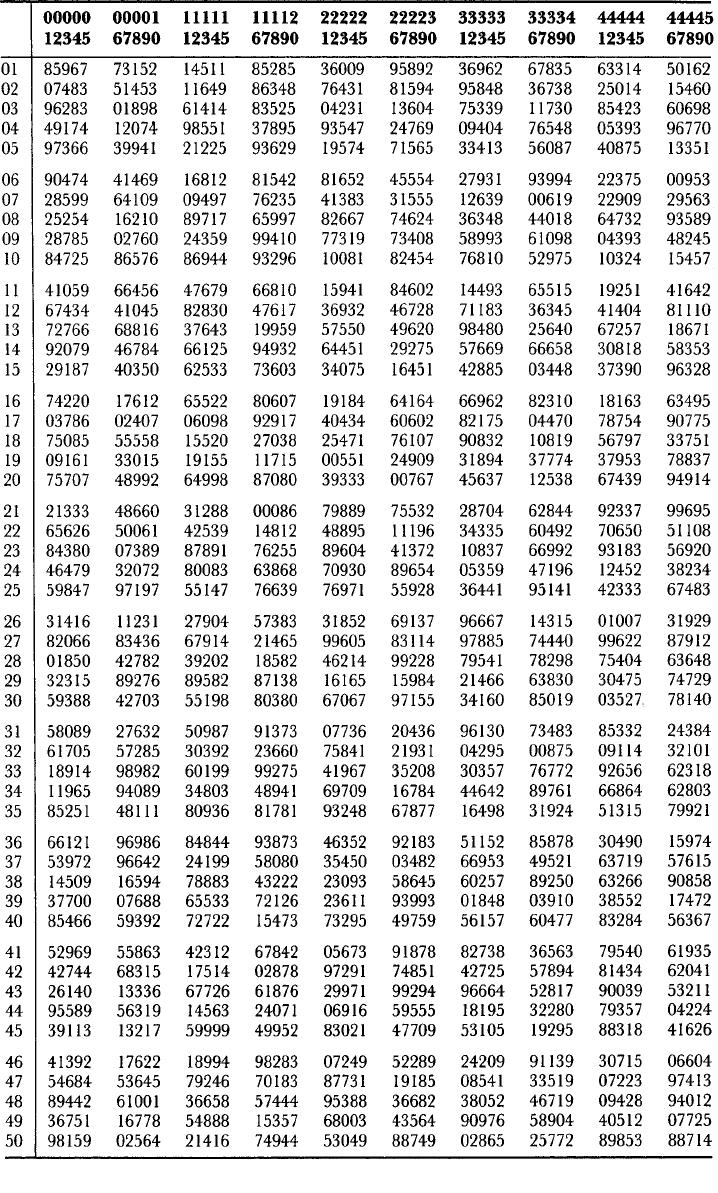Daniel W.W. Biostatistics: A Foundation for Analysis in the Health Sciences
Подождите немного. Документ загружается.


4. Immaturity ratio. This ratio is defined as
where
5. Secondary attack rate. This rate measures the occurrence of a contagious dis-
ease among susceptible persons who have been exposed to a primary case and is
defined as
where This rate is used to measure the spread of infection and is usually
applied to closed groups such as a household or classroom, where it can reason-
ably be assumed that all members were, indeed, contacts.
EXERCISES
14.4.1 Use the following facts to compute and label appropriate measures of morbidity.
(a) In 1997, in one of Georgia’s state districts, 504 of 6927 babies born weighed less than 2500
grams at time of birth. In 2001, in the same district, 675 of 8336 babies born weighed less than
2500 grams. [S
OURCE
: Georgia Vital Statistics Report, 1997 (A-14), and Georgia Natality Vital
Statistics Report, 2001 (A-10).]
(b) In 1999, the estimated number of cigarette smokers in Nevada was 430,000, and in the same
year, the estimated population of the state was 1,935,000. In the same year, 57,296,000 Americans
were current users of cigarettes, and the estimated population as of July 1, 1999 was 279,040,000.
[S
OURCE
: U.S. Substance Abuse and Mental Health Services Administration, National Household
Survey on Drug Abuse,1999, as reported in Statistical Abstracts of the United States: 2002 (118th
edition), U.S. Bureau of the Census, Washington, DC, 2002, Table No. 183; U.S. Census Bureau
State Population Estimates, as reported in Statistical Abstract of the United States: 2002 (118th
edition), U.S. Bureau of the Census, Washington, DC, 2002, Table No. 18 (A-15).]
(c) In 2000, in the United States, there were 40,758 reported new cases of acquired immunodefi-
ciency syndrome (AIDS). The estimated population of the United States as of July 1, 2000, was
281,421,906. [S
OURCE
: U.S. Centers for Disease Control and Prevention, Atlanta, GA, Summary
of Notifiable Diseases, United States, 2000, Morbidity and Mortality Weekly Report, Vol. 49, No.
53, June 14, 2002, and Statistical Abstract of the United States: 2002 (118th edition), U.S. Bureau
of the Census, Washington, DC, 2002, Table No. 174 (A-16).]
14.5 SUMMARY
This chapter is concerned with the computation and interpretation of various rates and
ratios that are useful in studying the health of a community. More specifically, we dis-
cuss the more important rates and ratios relating to births, deaths, and morbidity. Indi-
viduals who wish to continue their reading in this area may find the books by Kittleson
(1) and Smith (2) of interest.
k = 100.
number of additional cases among contacts of a
primary case within the maximum incubation period
total number of susceptible contacts
#
k
k = 100.
number of live births under 2500 grams during a year
total number of live births during the year
#
k
14.5 SUMMARY 777

SUMMARY OF FORMULAS FOR CHAPTER 14
Formula
Number Name Formula
14.1.1 Rate
14.1.2 Ratio
14.2— Annual crude
death rates death rate
and ratios
Annual specific
death rate
Age-adjusted
death rate
Maternal
mortality rate
Infant
mortality rate
Neonatal
mortality rate
Fetal death
rate
Fetal death
ratio
Perinatal
mortality
Cause-of-death
ratio
Proportional
mortality ratio
14.3— Crude birth
measures rate
of fertility
total number of live births during a year
total population as of July 1
#
k
number of deaths in a particular subgroup
total number of deaths
#
k
number of deaths due to a specific disease during a year
total number of deaths due to all causes during the year
#
k
+ (number of live births)
(number of fetal deaths of 28 weeks or more)
+ (infant deaths under 7 days)
(number of fetal deaths of 28 weeks or more)
#
k
total number of fetal deaths during a year
total number of live births during the year
#
k
total number of fetal deaths during a year
total number of deliveries during the year
#
k
number of deaths under 28 days of age during a year
total number of live births during the year
#
k
number of deaths under 1 year of age during a year
total number of live births during the year
#
k
deaths from all puerperal causes during a year
total live births during the year
#
k
total number of expected deaths
total standard population
#
k
total number of deaths in a specific subgroup during a year
total population in the specific subgroup as of July 1
#
k
total number of deaths during year
total population as of July 1
#
k
a
c
d
bk
a
a
a + b
bk
778 CHAPTER 14 VITAL STATISTICS

General
fertility rate
Age-specific
fertility rate
14.4— Incidence rate
measures of
morbidity
Prevalence
rate
Case-fatality
ratio
Immaturity
ratio
Secondary
attack rate
Symbol Key • a, b, c, d frequencies associated with the definition
of rates and ratios
• k multiplier for rates and ratios
REVIEW QUESTIONS AND EXERCISES
1. Explain the difference between a rate and a ratio.
2. Explain the difference between a crude death rate and a specific death rate.
3. Why is it inadvisable to compare the crude death rates of two geographic areas?
4. What is an adjusted or standardized death rate? What is the advantage of an adjusted death rate
over a crude death rate?
5. Define and discuss each of the following:
(a) Maternal mortality rate (h) Crude birth rate
(b) Infant mortality rate (i) General fertility rate
(c) Fetal death rate (j) Age-specific fertility rate
(d) Fetal death ratio (k) Total fertility rate
(e) Perinatal mortality rate (l) Cumulative fertility rate
(f) Cause-of-death ratio (m) Standardized fertility rate
(g) Proportional mortality ratio
6. What is morbidity?
number
of additional cases among contacts of a
primary case within the maximum incubation period
total number of susceptible contacts
#
k
total number of live births under 2500 grams during a year
total number of live births during the year
#
k
total number of deaths due to a disease
total number of cases due to the disease
#
k
total number of all diseases cases at a given point in time
total population at a given point in time
#
k
total number of new cases of a specific disease during a year
total population as of July 1
#
k
number of births to women of a certain age in a year
total number of women of the specified age
#
k
total number of live births during a year
total number of women of childbearing age
#
k
REVIEW QUESTIONS AND EXERCISES 779

7. Define and discuss the following morbidity measures:
(a) Incidence rate (d) Immaturity ratio
(b) Prevalence rate (e) Secondary attack rate
(c) Case-fatality ratio
8. For one or more geographical areas (for example, the United States, your state of residence, and
your county of residence) collect data and compute as many of the rates and ratios discussed in
this chapter as possible.
9. The following table shows, by age group, deaths in North Carolina during 2001, the estimated
population of North Carolina for 2001, and the population of the United States for 2000. Use these
data to compute the 2001 age-adjusted death rate for North Carolina. Use the 2000 U.S. popula-
tion as the standard population.
Age (Years) Population
a
Deaths
b
U.S. Population
c
0–4 566,740 1,178 19,175,798
5–14 1,140,934 224 41,077,577
15–24 1,130,671 954 39,183,891
25–34 1,210,066 1,384 39,891,724
35–44 1,293,741 2,823 45,148,527
45–54 1,124,305 5,271 37,677,952
55–64 753,533 8,035 24,274,684
65 and over 986,115 51,863 34,991,753
Total 8,206,105 71,732 281,421,906
Sources:
a
Table ST-EST2002-ASRO-02-37—State Characteristic Estimates,
Population Division, U.S. Census Bureau (A-17).
b
Selected Vital Statistics for 2001 and 1997–2001, North Carolina State
Center for Health Statistics (A-18).
c
Profile of General Demographic Characteristics: 2000, U.S. Census Bureau,
DP-1 for the United States (A-2).
10. The following data (numbers of specified events) are for a specific county in North Carolina for the
year 2001. Use these data to compute as many of the rates and ratios mentioned in this chapter as
possible.
Number
Total White Minority
Estimated population as of July 1, 2001 301,098 176,961 124,137
Total live births 5,315 3,093 2,222
Fetal deaths 45 21 24
Deaths
Total deaths all ages (excluding fetals) 1,989 1,222 767
Under 1 year 56 17 39
Under 28 days 40 9 31
Between 28 and 364 days 16 8 8
780 CHAPTER 14 VITAL STATISTICS
(Continued)

Number
Total White Minority
Low birth weight 480 201 279
Mother smoked 667 472 195
C-section 1,243 694 549
Source: Selected Vital Statistics for 2001 and 1997–2001, North Carolina State Center
for Health Statistics (A-18).
11. The following death data (number of deaths per category) are for the state of New York for
2000. Use these data to compute rates and/or ratios of interest. To the extent possible, com-
pare your results with those of Exercises 14.2.4 and comment on the comparison.
Total White Minority
a
Live births 285,455 182,285 103,170
Low birth weight 20,020 12,235 7,785
C-section 64,424 45,577 18,847
Infant deaths (under 1 year) 1,632 957 675
Death: males 74,636 61,873 12,763
Death: females 82,776 69,890 12,886
Cause of death: heart disease 57,921 49,624 8,297
Cause of death: cancer 37,277 31,351 5,926
Cause of death: AIDS 2,299 1,048 1,251
Source: Vital Statistics of New York State 2000 Tables, New York State
Department of Health (A-19).
a
The minority category includes all nonwhite and not stated races.
12. The following data are for the state of Georgia for 1994:
Age of Number of Births
Woman Number of Women to Women of
(Years) in Population
b
Specified Age
b
U.S. Population
c
10–14 246,026 599 17,114,249
15–19 251,197 17,329 17,754,015
20–24 259,413 31,333 19,020,312
25–29 287,951 28,940 21,313,045
30–34 300,358 22,588 21,862,887
35–39 298,578 8,777 19,963,117
40–44 278,679 1,329 17,615,786
45–49 229,377 43
a
13,872,573
Unknown — 46 —
a
May include some births to women over 49 years of age.
Sources:
b
Georgia Vital Statistics Report 1994, Georgia Department of Human Resources, Atlanta,
October 1995.
c
1990 Census of Population, United States, CP-1-1, Bureau of Census, Washington DC, November 1992,
Table 14.
REVIEW QUESTIONS AND EXERCISES 781

Use these data to compute the rates specified in Exercise 14.3.1. Compare the results with those
obtained in Exercises 14.3.1 and 14.3.3 where appropriate and comment on the comparison.
13. There was a total of 110,984 live births in Georgia in 1994. The estimated total population as of
July 1, 1994, was 6,965,539. See Review Exercise 12 for the number of women of childbearing
age. From these data compute the crude birth rate and the general fertility rate. Compare the results
with those of Exercises 14.3.2 and 14.3.4 and comment on the comparison.
14. Use the following facts to compute and label appropriate measures of morbidity.
(a) In 2000, in the United States, there were 1560 cases of Malaria. The estimated population of
the United States as of July 1, 2000, was 281,422,000. [S
OURCE
: U.S. Centers for Disease Control
and Prevention, Atlanta, GA, Summary of Notifiable Diseases, United States, 2000. Morbidity and
Mortality Weekly Report, Vol. 49, No. 53, June 14, 2002, and Statistical Abstract of the United
States: 2002 (118th edition), U.S. Bureau of the Census, Washington, DC, 2002, Table Nos. 18 and
174 (A-20).]
(b) In 2000, in the United States, there were 17,730 reported cases of Lyme disease. The esti-
mated population of the United States as of July 1, 2000, was 281,422,000. [S
OURCE
: U.S. Cen-
ters for Disease Control and Prevention, Atlanta, GA, Summary of Notifiable Diseases, United
States, 2000. Morbidity and Mortality Weekly Report, Vol. 49, No. 53, June 14, 2002, and Statis-
tical Abstract of the United States: 2002 (118th edition), U.S. Bureau of the Census, Washington,
DC, 2002, Table Nos. 18 and 174 (A-20).]
(c) In 1999, in Ohio, there were 436,000 estimated current users of marijuana. The estimated pop-
ulation of Ohio as of July 1, 2000, was 11,335,000. [S
OURCE
: U.S. Substance Abuse and Mental
Health Services Administration, National Household Survey on Drug Abuse, 1999, and Statistical
Abstract of the United States: 2002 (118th edition), U.S. Bureau of the Census, Washington, DC,
2002, Table Nos. 18 and 183 (A-21).]
REFERENCES
Methodology References
1. M
ARK
J. K
ITTLESON
, Vital Statistics for the Public Health Educator, Southern Illinois University Press, Carbon-
dale, 1996.
2. D
AVID
P. S
MITH
, Formal Demography, Plenum Press, New York, 1992.
Applications References
A-1. Georgia Vital and Morbidity Statistics 2000, Georgia Division of Public Health, Atlanta, http://www.ph.dhr.state
.ga.us/programs/ohip/birthdeath.shtml.
A-2. Profile of General Demographic Characteristics: 2000, U.S. Census Bureau DP-1, http://www.census.gov/
Press-Release/www/2001/tables/dp_us_2000.PDF.
A-3. 2000 Mortality Vital Statistics Reports, Georgia Office of Health Information and Policy, http://www.ph.dhr
.state.ga.us/pdfs/ohip/vsr/mortality.00.pdf, p. 25.
A-4. 1999 Mortality Vital Statistics Reports, Georgia Office of Health Information and Policy, http://www.ph.dhr
.state.ga.us/programs/ohip/pdfs/mortality1999rev.pdf, p. 14.
A-5. Profile of General Demographic Characteristics: 2000, U.S. Census Bureau, DP-1 for North Carolina, http://www
.census.gov/census2000/states/nc.html.
A-6. Selected Vital Statistics for 2000 and 1996–2000, North Carolina State Center for Health Statistics, http://www
.schs.state.nc.us/SCHS/vitalstats/volume1/2000/north_carolina.html.
782 CHAPTER 14 VITAL STATISTICS
A-7. Georgia Division of Public Health Online Analytical Statistical Information System (OASIS), http://oasis
.state.ga.us/webquery/population.html.
A-8. Georgia Natality Vital Statistics Reports, 2000, Georgia Division of Public Health, Atlanta, http://www.ph.dhr
.state.ga.us/pdfs/ohip/vsr/natality.00.pdf, p. 23.
A-9. Age Groups and Sex: 2000, U.S. Census Bureau 2000 Summary file QT-P1 for United States. http://factfinder
.census.gov/servlet/QTTable?_bm=y&-geo_id=D&-qr_name=DEC_2000_SFI_U_QTP1&-ds_name=D&-_lang
=en&-redoLog=false.
A-10. Georgia Natality Vital Statistics Reports, 2001, Georgia Division of Public Health, Atlanta, http://www.ph.dhr
.state.ga.us/pdfs/ohip/vsr/natality.01.pdf, p. 23.
A-11. Georgia Vital Statistics Reports, Births and Deaths, 2001, Georgia Division of Public Health, Atlanta,
http://www.ph.dhr.state.ga.us/pdfs/ohip/vsr/population.01.pdf, p. 23.
A-12. North Carolina Resident Births for 2000 by Age of Mother and Birth Order for All Women, North Carolina
Department of Health and Human Services, State Center for Health Statistics, http://www.schs.state.nc.us/
SCHS/births/babybook/2000/counties/northcarolina.pdf.
A-13. Age Groups and Sex: 2000, U.S. Census Bureau 2000 Summary file QT-P1 for North Carolina, http://factfinder.
census.gov/servlet/DTGeoSearchByListServlet?ds_name=DEC_2000_SF1_U&_lang=en&_ts=103465481955.
A-14. Georgia Vital Statistics Report, 1997, Georgia Division of Public Health, Atlanta, http://www.ph.dhr.state.ga.us/
programs/ohip/pdfs/birthdeath97/statebirthdeath.pdf.
A-15. Statistical Abstract of the United States: 2002 (118th edition), U.S. Bureau of the Census, Washington, DC, 2002,
Table No. 18, Table No. 183. http:///www.census.gov/prod/2003pubs/02statab/pop.pdf [for population data]/
health.pdf [for smoking data].
A-16. Statistical Abstract of the United States: 2002 (118th edition), U.S. Bureau of the Census, Washington, DC,
2002, Table No. 174, http://www.census.gov/prod/www/statistical-abstract-02.html.
A-17. State Characteristic Estimates, Table ST-EST2002-ASRO-02-37, Population Division, U.S. Census Bureau,
http://eire.census.gov/popest/.
A-18. Selected Vital Statistics for 2001 and 1997–2001, North Carolina State Center for Health Statistics, http://www
.schs.state.nc.us/SCHS/vitalstats/volume1/2001/nc.html.
A-19. Vital Statistics of New York State 2000 Tables, New York State Department of Health, http://www.health
.state.ny.us/nysdoh/vital_statistics/2000/toc.htm.
A-20. Statistical Abstract of the United States: 2002 (118th edition), U.S. Bureau of the Census, Washington, DC,
2002, Table Nos. 18 and 174, http://www.census.gov/prod/www/statistical-abstract-02.html.
A-21. Statistical Abstract of the United States: 2002 (118th edition), U.S. Bureau of the Census, Washington, DC,
2002, Table Nos. 18 and 183, http://www.census.gov/prod/www/statistical-abstract-02.html.
REFERENCES 783
This page intentionally left blank

A-1
List of Tables
A. Random Digits
B. Cumulative Binomial Probability Distribution
C. Cumulative Poisson Distribution
D. Normal Curve Areas
E. Percentiles of the t Distribution
F. Percentiles of the Chi-Square Distribution
G. Percentiles of the F Distribution
H. Percentage Points of the Studentized Range
I. Transformation of r to z
J. Significance Tests in a 2 2 Contingency Table
K. Probability Levels for the Wilcoxon Signed Rank Test
L. Quantiles of the Mann–Whitney Test Statistic
M. Quantiles of the Kolmogorov Test Statistic
N. Critical Values of the Kruskal–Wallis Test Statistic
O. Exact Distribution of for Tables with from 2 to 9 Sets of Three Ranks
P. Critical Values of the Spearman Test Statistic
x
2
r
APPENDIX
STATISTICAL TABLES

TABLE A Random Digits
